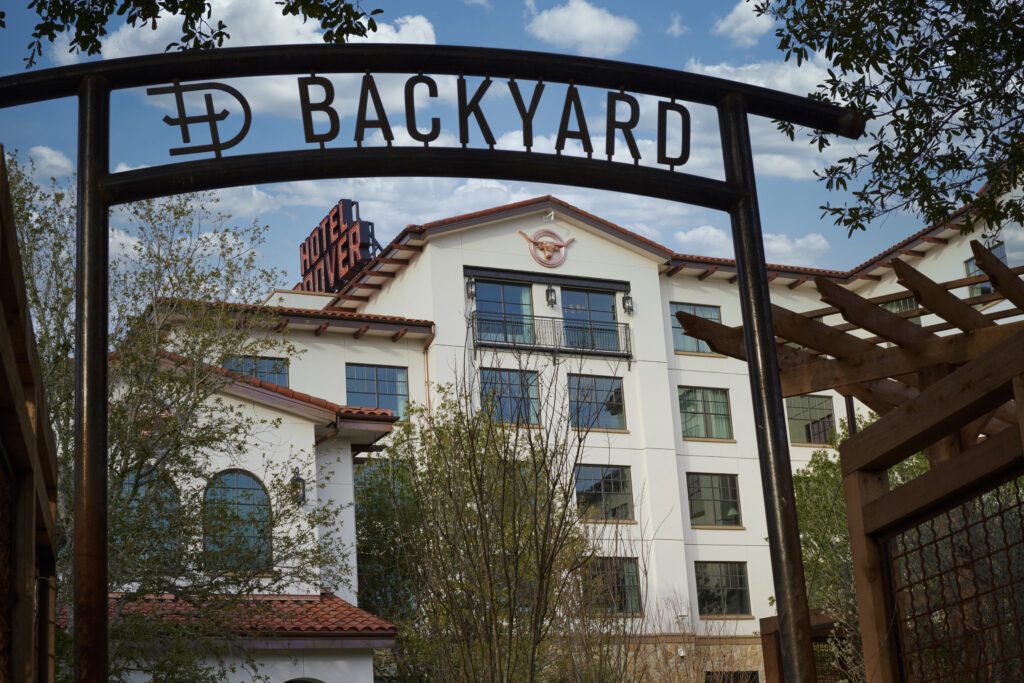Stockyards Redevelopment Is on a Roll
Fort Worth has plenty of reasons to boast about the transformative change that has parlayed the city into a top destination for visitors and a great place for locals to call home.
Despite the challenges of the coronavirus pandemic, Fort Worth has experienced a dizzying array of new development and redevelopment, resulting in the opening of the world-class Dickies Arena and the revitalization of the Near Southside.

The Backyard at Hotel Drover, shared by permission from FWBP
But for all the anticipation it created and controversy it stirred before a shovel of dirt turned, it is the redevelopment of the Stockyards that stands tall as a remarkable accomplishment and a testament to the longstanding claim that Fort Worth is “where the West begins.”
The horse and mule barns built in 1912 when the Stockyards became the largest livestock trading center in the Southwest have been transformed into Mule Alley, a vibrant western heritage entertainment center that is home to restaurants, bars, retail shops and its centerpiece, Hotel Drover.
And Mule Alley is just the beginning of sweeping changes planned for the Stockyards by Stockyards Heritage Development Co., a partnership between the Fort Worth-based Hickman Companies and California-based Majestic Realty Co.
The development firm entered a multi-phase agreement with the city of Fort Worth to carry out development and redevelopment of the Stockyards in exchange for tax breaks of up to $26 million, beginning with the Mule Alley and Hotel Drover project in 2018.

Craig Cavileer, shared by permission from FWBP
In a State of the Market presentation held at Hotel Drover on June 21, Craig Cavileer, managing partner of Stockyards Heritage Development Co. and executive president of Majestic Realty Co., said another phase of development will kick off this year just as retail and hospitality space in Mule Alley fills up.
Due to come in Mule Alley are two new ventures by chef Tim Love, who recently opened Paloma Suerte, a Tex-Mex inspired restaurant. Caterina’s, an Italian eatery, is set to open soon, according to Cavileer.
Later this year, a partnership between Love and global entertainment company, Live Nation, will add Tannahill’s Tavern & Music Hall to the mix in Mule Alley. Cavileer described the planned 24,000-square-foot venue as “something that only Tim Love and Live Nation could do.”
“It will be House of Blues Stockyards style. We anticipate it will present 140 to 150 concerts a year,” he said.
Although the agreement stipulated a $175 million investment, Stockyards Heritage Development has spent about $200 million on the Mule Alley and Hotel Drover project, according to Cavileer.
But the return on investment includes an overwhelming response from tourists and locals in visits to the Stockyards. Before the redevelopment project, about 3 million people visited the Stockyards annually. The redevelopment of Mule Alley and Hotel Drover has increased visitation to about 8 million people, according to Cavileer.
“What we’re seeing is a lot of the same people coming more often, about every 90 days,” he said.
Helping drive traffic is the experience that offers something for people of all ages and media attention from travel publications, including an upcoming ranking of Hotel Drover among the top hotels in the nation and world, Cavileer said.
Since the Mule Alley and Hotel Drover project was largely adaptive reuse, it only used about three of the 70 acres the developers own in the 200-acre Stockyards Historic District.
Other major projects in the Stockyards will consume more acreage, particularly a luxury multi-family development that is expected to break ground later this year. It will be part of a 15-acre master-planned development of the former Swift & Co. property, a remnant of the Stockyards’ heyday as a meat-packing center. The multi-story building will have a rooftop pool among its amenities, according to Cavileer.
Stockyards Heritage Development recently acquired the historic Stockyards Hotel, H3 Ranch restaurant and Booger Red’s Saloon and Bar.
Built in 1907, the 115-year-old hotel is listed on the National Register of Historic Places. It has hosted numerous celebrity guests, including George Strait, Garth Brooks, Randy Travis and Willie Nelson. It also accommodated the notorious Clyde Barrow and Bonnie Parker in 1933.
The hotel’s last upgrade was in 1982 so there are upgrades needed, such as new windows, to preserve and protect the iconic building, Cavileer said. Those improvements will also begin this year, he said.
Another project set to begin this year is a major renovation of the Cowtown Coliseum, which Stockyards Heritage Development manages and promotes, as a result of the decision by PBR (Professional Bull Riders) to relocate from Las Vegas to Fort Worth last year.
An agreement between the development company, PBR and ASM Global was intended to increase western sporting events at the city-owned Cowtown Coliseum as well as produce concerts and other live entertainment at the historic coliseum, which began construction in 1907.
Significant improvements are planned for the Coliseum, especially upgrades to the audio system, in preparation for it to host 60 to 70 events a year, Cavileer said.
“There’s a lot of work to be done,” Cavileer said, particularly since not much has been done “since Elvis Presley performed there in the 1950s.”
Cavileer also participated in a panel discussion on commercial real estate matters, including the strength of Fort Worth’s market compared to other cities across the country, the future of the office market, economic development and corporate relocations opportunities and public transportation improvements to connect people between downtown Fort Worth, the cultural district and the Stockyards.
A separate panel discussed industrial real estate, which panelists agreed was “the darling of commercial real estate” in the Dallas-Fort Worth market.
This article, by Marice Richter, originally appeared in the Fort Worth Business Press and is shared with permission.


 Sign in
Sign in

